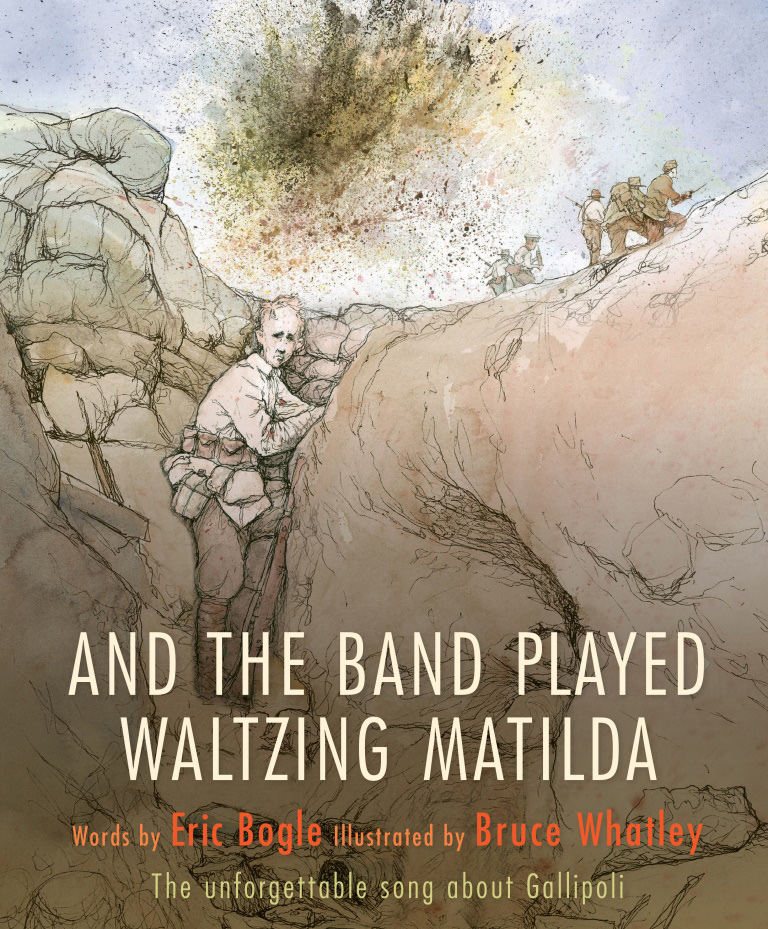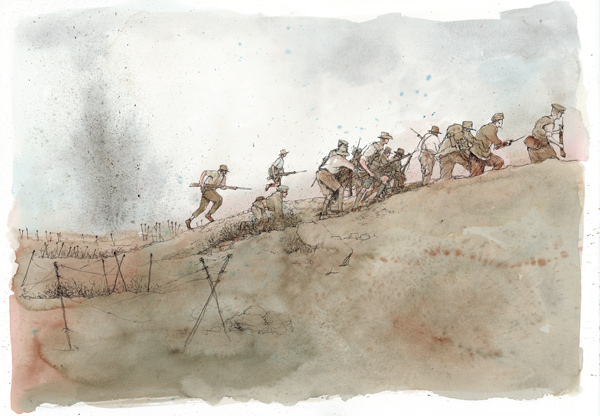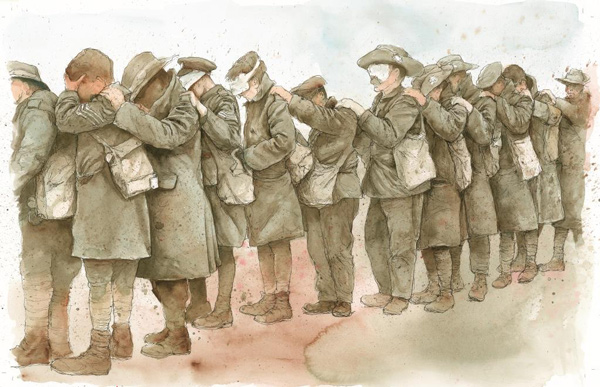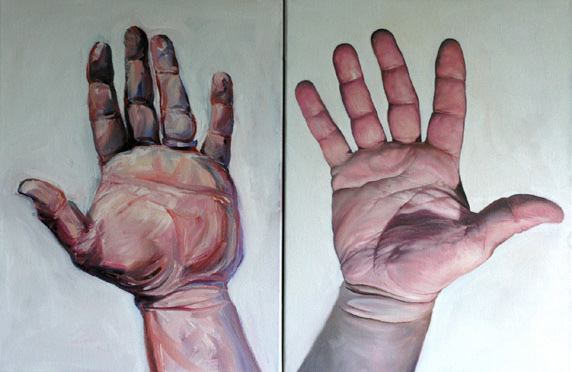And The Band Played Waltzing Matilda, words by Eric Bogle, illustrated by Bruce Whatley, published by A&U
– Review and Publishing Process –
This book was first released in January 2015, and it’s still in print in 2022 because it’s one of the best books ever created.
Eric Bogle’s haunting song always tugs at the heart strings as the optimism of troops leaving for Gallipoli turns to bloodshed and tears, and ‘…the crippled, the wounded, the maimed…’ return home. (It’s available on iTunes for students or anyone who is unfamiliar with it being sung.) But now we have Bruce Whatley’s masterful emotion-charged illustrations as an accompaniment to help increase our appreciation of the heroics and suffering of those who fought, and especially the feelings of surviving veterans. Readers of this book, however, will never see the pictures simply as ‘an extra layer’, but rather find that the illustrations are solidly bound to the words to the extent that whenever the song is heard, it will always conjure a vision of Bruce’s artwork.
As if words and images were not powerful enough on their own, in this book they have been enhanced by unsung maestros in the publishing industry who create a spectacular book’s design and production values, in consultation with experienced editors, sales and marketing staff, and in this case, with Bruce, too. The small things add together to become a big thing: the slightly textured wood-free cream paper specially sourced by the production manager, which I have never seen used in any other book, hints at the ‘matt cream’ photographic paper used in the early 20th century; the obvious stitching of the sections shows the quality of the binding …and then there’s the stunning fabric-feel cover conceived by designer Sandra Nobes and editor Elise Jones after considering many options. The lettering is deeply ‘debossed’ – indented into the surface to give the same appearance that designer bookbinders establish by using brass hand-tools, heat and pressure to add gold and coloured-foil titles to the finest leather bound volumes. And, as I discovered by asking Allen and Unwin’s publisher, Anna McFarlane, and Bruce some leading questions, though the initial cover roughs planned to use an element from an internal spread, a later decision was made to specially commission Bruce to create the final cover picture with more trench and less detail showing for the type to run across.
This cover art is phenomenal and a foretaste of what we will discover on the pages, and also a lesson in itself for would-be illustrators: the action takes place from left to right, as we normally read text; the main character stares towards us and draws us in to his situation in the narrow trench, and we are forced to make eye contact by the position of his eyes on the page – at an intersection of lines that could be drawn a third of the way across from a side, and a third of the height of the picture – and many lines in the drawing lead our eyes to his: the sloping hillside horizon, edges of boulders and the cleft in the trench wall on the right.
Though Bruce has illustrated many books using his dominant right hand, he instantly chose to draw all the illustrations for this book with his left hand (as he has done for some earlier titles), which he has found can give a more expressive portrayal of emotions. For me, the slightly fragmented nature or ‘wiggliness’ of some lines also highlights the fragility of the human body and the precarious situation faced by all service people on a battlefield.
While some illustrations are obvious choices – the ship heading out of the harbour, for example – others cause us to ponder and reflect. Is the figure on the cover warning us to stay away from the danger to be faced and sights he is likely to see, reflecting on the futility of war and loss of life, or asking us to join him in the story and support him in action, as a mate? We know we must stay with him through thick and thin.
Bruce sourced photographs that were taken at the time and which he felt best illustrated the various passages of the text, and sketched scenes from these. There is nothing glorious about the brutalities of war, and Bruce’s portrayal in predominantly sepia tones emphasises the barren landscape, mud and the bleakness of the situation the soldiers faced in the field and also in the treatment of wounds in hospital – and in their difficult repatriation.
As Bruce reflected in our email correspondence,
“I don’t know what age you can talk about the death of a sibling or the illness of a parent. But as someone once pointed out to me there are a lot of children who are affected by such things and having these subject matters discussed in the form of a picture book might help. It might also help other children understand what friends and strangers they see on the news might be going through.
War is the same, I think, especially at the moment as it tends to saturate our media. Often war is glorified or dramatized. I wanted to give the most realistic interpretation I could. But ultimately it is up to the parents and teachers to decide if this book is right for each individual child.”
Bruce graphically shows us both the physical and mental scars of veterans, and indeed, by reading this book hopefully children’s and our own empathy is heightened with all who serve or have served as military personnel, and also with others who have been traumatised by war, witnessing a tragedy or the loss of a family member or friend. My uncle suffered as a prisoner on the Burma Railway but described burning the bodies of friends who had died from cholera as one of his worst experiences.
What do you think is being recalled most by the veterans that Bruce has drawn?
More revelations of the publishing process, as shared by Allen and Unwin publisher/editor Anna McFarlane and Bruce Whatley
Peter: Did the idea for this book come from Bruce or Eric, or the A&U ‘think-tank’ or…? You are so fortunate to have Bruce illustrate it – I know he has many projects on the go.
Anna: I have always loved the song …but the idea to turn it into a picture book was a Eureka moment: I had been researching possible titles for a novel about World War II that I was publishing, and was listening to the song as inspiration. At the time we were signing up John Schumann’s iconic song, ‘I Was Only Nineteen’ (which Craig Smith then illustrated so brilliantly and we published in 2014) and a picture book of ‘And the Band Played Waltzing Matilda’ seemed like an obvious thing to do. I talked about the idea with the team, and everyone could see the potential. We all agreed it would be amazing if Bruce would illustrate it – we had worked with him on The Little Refugee and it just seemed right for him. I then approached Bruce – he was really busy, but I think he felt, like we did, that he just had to do this book.
Peter: How long ago did the process start?
Anna: We approached Bruce in September 2012. We saw roughs and one piece of artwork in October 2013 and I think all of the artwork was delivered by June 2014. As I said, Bruce was very busy but we were prepared to wait!
Peter: Can you tell us a little about the publishing process?
Anna: All decisions are team decisions at a publishing house as the publisher listens to everyone’s feedback: editors, fellow publishers, sales and marketing people. Early ideas are often run past colleagues, but once we know we definitely want to publish something, we take the project to an ‘acquisition meeting’ which is where we officially gather feedback from sales, marketing, publicity and rights.
With a picture book, we will start with the text but we tend not to present the concept to that meeting until we have an illustrator ‘attached’. We generally have the text as well as an example of the illustrator’s style or roughs to show, but in this case, Bruce was so well-known, there was no need for roughs.
Peter: Before saying to an illustrator “Go ahead and start drawing and painting, and we need the art by 1 July”, is there still a need for top artists to produce a story board and dummy for discussion? At what stages does the art director and editor like to be involved?
Anna: Every picture book I have published has had a stage at which we looked at either a storyboard or thumbnails. The editor and the designer work most closely with the illustrator and respond to him or her depending on their need and/or experience. With ‘And the Band Played Waltzing Matilda’, Bruce had a clear vision on how it would look on the page, what part of the song would go on which page but we consulted with him on choice and size of font and positioning of text, as well as paper stock.
Peter: Who usually sets the book dimensions – at what stage? After the illustrator has created a storyboard? Before they create a dummy, or as a result of the dummy
Anna: There are practical requirements when it comes to size (ie the book has to be able to fit on a bookshelf) but the style of artwork also informs the picture book’s dimensions. So the trim size is something that is decided in consultation with the illustrator. Bruce felt the natural trim size for this book was similar to ‘The Little Refugee’ and we thought that would be a good size too given how much text would need to be on the page and the general gravitas of the book.
Bruce brought in the first piece of art in October 2013 along with the layouts. The power of the piece was immediately obvious. In fact I think I might have cried.
The production of ‘And the Band Played Waltzing Matilda’ was incredibly smooth.
Peter: Thanks so much, Anna!
https://www.allenandunwin.com/about-allen-and-unwin
Peter to Bruce: Everyone knows you are a master illustrator and a genius – so do publishers still ask to see sketches and your storyboard before you start? How do they work with you?
Bruce: I’ve been fortunate to have a good relationship with my publishers and they know what to expect from me. They are also very generous and let me run with an idea or a new way of illustrating. I produce fairly rough dummy sketches to show my editors what I have in mind. From there we might discuss changes and that could be to the illustrations or the text now that the visual narrative is worked out. I don’t produce very detailed pencil drawings before I illustrate though – most of the work is done on my art paper just before I apply the paint etc.
Covers are always a big issue for me. I put down the basic design for most of my books but love it when there is a good designer on board that enhances what I do and takes it to an area I wouldn’t have thought of.
Peter: I understand that covers are now usually decided by a committee that’s often heavily influenced by the sales and marketing departments. I’ve heard that can lead to the choice of a ‘safe’ design option and dampen inspiration, creativity and ‘gut feel’. I guess we shouldn’t go there – it’s the publisher who invests their money.
Peter: At what stages in the process does the publisher get to see the direction that you’re taking it – what do you show them? A ‘dummy’ book? A small sample in the finished style or a full-sized artwork?
Bruce: I used to make up a physical dummy of my books but now I produce a series of page layouts. I’ll sketch the illustrations and add the text in the composition format I’m thinking of. Where I would send hard copies of this to my editors in the past I tend to send them digitally now. Editors prefer that, it’s more instant and they can work on them easier and print them out when needed. My editors don’t see a sample illustration before-hand though I will show them the first couple of illustrations when they are complete, just to make sure they are happy with where I’m going.
Peter: Do you mix a vast quantity of paint to ensure constant colour throughout all artworks? How much?
Bruce: No, I don’t need to mix up a bulk of paint. For years I’ve used a very restrictive pallet of 5 colours plus black and white. Purple and sometimes a particular blue are the only other colours I might grab. I do make sure I have enough art paper to finish each project though. I have come unstuck in the past when a particular art paper became unavailable.
Peter: Am I right in thinking that your drawings fill most of a full sheet of hot-pressed watercolour paper? You don’t stretch that, do you?
Bruce: Yes, I tend to work on a thick watercolour paper. I find I don’t need to stretch it before painting. Even when I illustrated ‘Flood’ where I used a lot more water, it didn’t seem a concern. Any buckling seems to flatten out eventually.
Peter: I know you often draw with your left hand but do you paint with it, too?
Yes, when I did my PhD an exhibition of major work was a part of it. There I had a mixture of left and right handed paintings. Using photograph references, here’s a painting of my left hand done with my left and my right hand done with my right.
Peter: Did you deliver your artwork to A&U to get drum scanned or did you provide the files?
Bruce: Yes, though the process is constantly changing. I moved from working on board about 20 years ago because they brought in the drum scanners. But now I think they are moving back to flat scans. In the US you are now expected to send them scans.
Peter: What was your action plan?
Bruce: There wasn’t a lot of time – the deadline was for it to be out before April this year, and I actually started work on the book before I signed the contract. The first job was to work out the pagination from the text. As the text was the lyrics for a song it was not obvious where the page breaks should be. …From there I gathered my visual references and sketched out the pages, then I presented the completed page layouts with the illustration for the first spread to my editor, Anna McFarlane. Once approved, I proceeded with the rest of the illustrations. I worked closely with the designer Elise Jones on the cover and she had some great suggestions for design and texture. Colour proofs came through a couple of months after delivery of artwork – only minor things needed adjusting.
Peter: Many thanks, Bruce!
Bruce’s website: http://brucewhatley.com/
And The Band Played Waltzing Matilda
Words: Eric Bogle Illustration: Bruce Whatley
Publisher: Allen & Unwin 2015
ISBN: 9781743317051
Short-listed CBCA Picture Book of the Year 2016 AU
Ages 8-14
Review and Interview by Peter Taylor
First appeared in Q Review, a former online magazine for members of the Queensland branch of the Children’s Book Council of Australia






